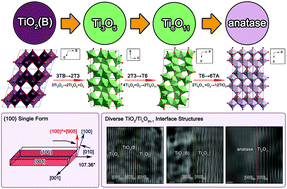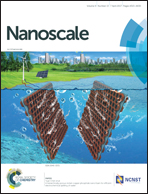Atomic-scale investigation of a new phase transformation process in TiO2 nanofibers†
Abstract
Crystallography of phase transformation combining transmission electron microscopy (TEM) with in situ heating techniques and X-ray diffraction (XRD) can provide critical information regarding solid-state phase transitions and the transition-induced interfaces in TiO2 nanomaterials theoretically and experimentally. Two types of reduced titanium oxides (Ti3O5, Ti6O11) are found during ex situ and in situ heating of TiO2 (B) nanofibers with a specific morphology of the {100} single form (SF) in air and vacuum. The results indicate that the phase transformation process from TiO2 (B) follows the TiO2 (B) → Ti3O5 → Ti6O11 → anatase sequence for the nanofibers with the {100} SF. The occurrence of such a phase transition is selective to the morphology of TiO2 (B) nanofibers. The corresponding orientation relationships (COR) between the four phases are revealed according to the TEM characterization. Four types of coherent interfaces, following the CORs are also found. They are TiO2 (B)/Ti3O5, TiO2 (B)/Ti6O11, Ti6O11/anatase and TiO2 (B)/anatase respectively. The habit plane for the TiO2 (B) to Ti3O5 transition is calculated as the {100}TB by using the invariant line model. The detailed atomic transformation mechanism is elucidated based on the crystallographic features of the four phases.



 Please wait while we load your content...
Please wait while we load your content...